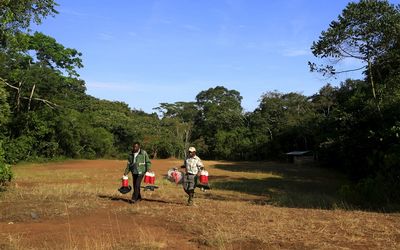ENTEBBE — From a hill above the shores of Lake Victoria, forest caretaker Gerald Mukisa looked down on a little-used observation tower that helped researchers discover the mosquito-borne Zika virus here nearly 70 years ago.
"There are all sorts of mosquitoes, monkeys, birds and snakes," he said as he trekked down a winding path to the 36m steel tower. "We are receiving more visitors than before."
Researchers are combing this forest for clues that might reveal how a normally mild mosquito-borne disease sparked a global public-health emergency this year, blamed for a startling rise in birth defects and a neurological disorder. Across Africa, health officials are heightening surveillance for a virus that once attracted little notice but that many say may have caused similar, undetected complications in the past.
As Zika spreads rapidly through the Americas, where it has been reported in 33 countries and territories, according to the World Health Organisation (WHO), officials are stepping up efforts to monitor for the virus near the forests from which it came nearly 70 years ago.
"We are advising countries to put in place a surveillance system," said Ibrahima-Soce Fall, director of health security and emergencies for the WHO’s Africa office. Increasing urbanisation had put Africa at greater risk than ever, he said, because the mosquito that spread Zika — along with the much more severe diseases yellow fever, dengue and chikungunya — thrived in those densely populated tropical spaces. "This mosquito is everywhere," he said.
While many Africans are believed to be immune to Zika because it has spread for so long, concern about its complications has health officials on alert. The virus circulating in the Americas is a slightly different strain from the one that emerged in Africa decades ago. The WHO’s Africa office says 20 countries on the continent face the greatest risk of a Zika outbreak based on past cases of infection and their capacity to respond to a flare-up.
The island nation of Cape Verde is in the midst of an outbreak now, with 7,490 cases reported, and the country reported a case of microcephaly in mid-March. Nigeria and Ethiopia were also at high risk because of their huge populations, Dr Fall said.
In Uganda, Julius Lutwama leads virologists at the Virus Research Institute who are poring over blood samples and parasites from across the nation to see whether Zika might be returning to its roots.
This is the second time in recent years that Ugandan epidemiologists and researchers have been called on to help solve a global health crisis. As Ebola exploded in West Africa in 2014, lessons from Uganda’s five outbreaks since 2000 helped experts identify flare-ups more easily. In February, Dr Lutwama led a team of Ugandan health workers that visited the US Centres for Disease Control and Prevention (CDC) in Atlanta to discuss his country’s Zika expertise.
In 1947, scientists studying yellow fever in Uganda stumbled across a new virus in the blood of a feverish rhesus monkey. They named it Zika, after the dense forest where the monkey lived. The word means overgrown in the local Luganda language.
It was five years before Zika showed up in humans, in Uganda and Tanzania, before spreading to West and North Africa. From there, about 50 years ago, Zika is believed to have spread to Asia.
Now, the largest known Zika epidemic in history has suggested what scientists say are likely links between the virus and a congenital abnormality in newborns called microcephaly. The children are born with undersized skulls and brains, and many have significant brain damage. Zika is also now linked to Guillain-Barre syndrome, a neurological condition. Researchers now believe past Zika outbreaks in Africa, and possible complications like microcephaly, simply were not noticed.
"If you don’t have surveillance, you can’t know what people are dying of," said Joia Mukherjee, chief medical officer for Partners in Health, a Boston-based nonprofit organisation that works in five African nations. "Most people wouldn’t come to medical attention."
Surveys in Nigeria, Senegal and other countries on the continent have found Zika antibodies in human blood samples, according to an analysis by researchers at Harvard Medical School. The analysis also notes that a study of 3,196 infants born in Lagos, Nigeria, from 2005 to 2007 found that 10.6% had microcephaly. That is much higher than the fewer than 12 cases reported for each 10,000 births in the US, the CDC says.
But making any link between microcephaly and Zika is difficult in Africa, because other causes of the congenital condition are also rife, the WHO says. The Lagos study explored a link between microcephaly and congenital cytomegalovirus, another virus, according to its author, Bolajoko O Olusanya, director of the Centre for Healthy Start Initiative in Lagos.
Dr Lutwama believes the Aedes aegypti mosquito species that carries Zika in Uganda’s deep forests prefers to prey on mammals other than people. Genetic sequencing showed the Zika virus rampaging through the Americas had mutated slightly since it was discovered in Africa, he said.
"The strain spreading through South America is the Asian type, whose genome has slightly changed, making it more adaptable to the human body," Dr Lutwama said.
But the Zika forest is less than half the size it was when Zika was discovered, thanks to logging and farming. Researchers fear Zika-carrying mosquitoes may have no choice but to bite humans more regularly as their habitat shrinks.
That means more of the pathogens hiding in central Africa’s deep forests are coming into contact with the region’s growing population more often. "We keep discovering new viruses," Dr Lutwama said.
More Africa news from The Wall Street Journal
More news from The Wall Street Journal
Premium access to WSJ.com: $1 a week for 12 weeks

Researchers from the Uganda Virus Research Institute carry insect traps at the Zika Forest in Entebbe, south of Uganda's capital Kampala. Picture: REUTERS
ENTEBBE — From a hill above the shores of Lake Victoria, forest caretaker Gerald Mukisa looked down on a little-used observation tower that helped researchers discover the mosquito-borne Zika virus here nearly 70 years ago.
"There are all sorts of mosquitoes, monkeys, birds and snakes," he said as he trekked down a winding path to the 36m steel tower. "We are receiving more visitors than before."
Researchers are combing this forest for clues that might reveal how a normally mild mosquito-borne disease sparked a global public-health emergency this year, blamed for a startling rise in birth defects and a neurological disorder. Across Africa, health officials are heightening surveillance for a virus that once attracted little notice but that many say may have caused similar, undetected complications in the past.
As Zika spreads rapidly through the Americas, where it has been reported in 33 countries and territories, according to the World Health Organisation (WHO), officials are stepping up efforts to monitor for the virus near the forests from which it came nearly 70 years ago.
"We are advising countries to put in place a surveillance system," said Ibrahima-Soce Fall, director of health security and emergencies for the WHO’s Africa office. Increasing urbanisation had put Africa at greater risk than ever, he said, because the mosquito that spread Zika — along with the much more severe diseases yellow fever, dengue and chikungunya — thrived in those densely populated tropical spaces. "This mosquito is everywhere," he said.
While many Africans are believed to be immune to Zika because it has spread for so long, concern about its complications has health officials on alert. The virus circulating in the Americas is a slightly different strain from the one that emerged in Africa decades ago. The WHO’s Africa office says 20 countries on the continent face the greatest risk of a Zika outbreak based on past cases of infection and their capacity to respond to a flare-up.
The island nation of Cape Verde is in the midst of an outbreak now, with 7,490 cases reported, and the country reported a case of microcephaly in mid-March. Nigeria and Ethiopia were also at high risk because of their huge populations, Dr Fall said.
In Uganda, Julius Lutwama leads virologists at the Virus Research Institute who are poring over blood samples and parasites from across the nation to see whether Zika might be returning to its roots.
This is the second time in recent years that Ugandan epidemiologists and researchers have been called on to help solve a global health crisis. As Ebola exploded in West Africa in 2014, lessons from Uganda’s five outbreaks since 2000 helped experts identify flare-ups more easily. In February, Dr Lutwama led a team of Ugandan health workers that visited the US Centres for Disease Control and Prevention (CDC) in Atlanta to discuss his country’s Zika expertise.
In 1947, scientists studying yellow fever in Uganda stumbled across a new virus in the blood of a feverish rhesus monkey. They named it Zika, after the dense forest where the monkey lived. The word means overgrown in the local Luganda language.
It was five years before Zika showed up in humans, in Uganda and Tanzania, before spreading to West and North Africa. From there, about 50 years ago, Zika is believed to have spread to Asia.
Now, the largest known Zika epidemic in history has suggested what scientists say are likely links between the virus and a congenital abnormality in newborns called microcephaly. The children are born with undersized skulls and brains, and many have significant brain damage. Zika is also now linked to Guillain-Barre syndrome, a neurological condition. Researchers now believe past Zika outbreaks in Africa, and possible complications like microcephaly, simply were not noticed.
"If you don’t have surveillance, you can’t know what people are dying of," said Joia Mukherjee, chief medical officer for Partners in Health, a Boston-based nonprofit organisation that works in five African nations. "Most people wouldn’t come to medical attention."
Surveys in Nigeria, Senegal and other countries on the continent have found Zika antibodies in human blood samples, according to an analysis by researchers at Harvard Medical School. The analysis also notes that a study of 3,196 infants born in Lagos, Nigeria, from 2005 to 2007 found that 10.6% had microcephaly. That is much higher than the fewer than 12 cases reported for each 10,000 births in the US, the CDC says.
But making any link between microcephaly and Zika is difficult in Africa, because other causes of the congenital condition are also rife, the WHO says. The Lagos study explored a link between microcephaly and congenital cytomegalovirus, another virus, according to its author, Bolajoko O Olusanya, director of the Centre for Healthy Start Initiative in Lagos.
Dr Lutwama believes the Aedes aegypti mosquito species that carries Zika in Uganda’s deep forests prefers to prey on mammals other than people. Genetic sequencing showed the Zika virus rampaging through the Americas had mutated slightly since it was discovered in Africa, he said.
"The strain spreading through South America is the Asian type, whose genome has slightly changed, making it more adaptable to the human body," Dr Lutwama said.
But the Zika forest is less than half the size it was when Zika was discovered, thanks to logging and farming. Researchers fear Zika-carrying mosquitoes may have no choice but to bite humans more regularly as their habitat shrinks.
That means more of the pathogens hiding in central Africa’s deep forests are coming into contact with the region’s growing population more often. "We keep discovering new viruses," Dr Lutwama said.
More Africa news from The Wall Street Journal
More news from The Wall Street Journal
Premium access to WSJ.com: $1 a week for 12 weeks





















Change: -0.80%
Change: -1.03%
Change: -0.24%
Change: -1.13%
Change: -1.10%
Data supplied by Profile Data
Change: 0.13%
Change: 0.07%
Change: -0.80%
Change: 0.00%
Change: 0.20%
Data supplied by Profile Data
Change: 0.07%
Change: -1.06%
Change: -0.14%
Change: -0.07%
Change: 0.70%
Data supplied by Profile Data
Change: 0.39%
Change: 1.33%
Change: 0.13%
Change: 0.67%
Change: 0.65%
Data supplied by Profile Data